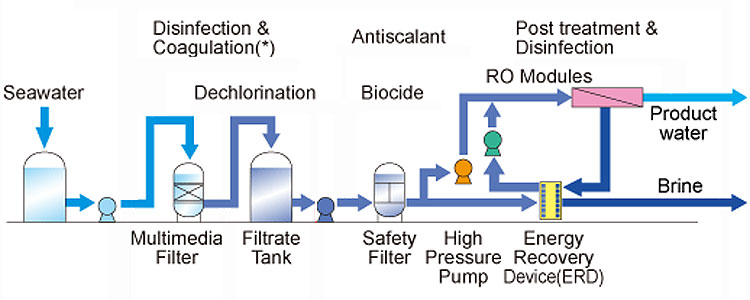Why doesn’t California, USA, invest in a seawater desalination plant?
California, USA, is located on the Pacific coast and has abundant seawater resources, but faces the challenge of fresh water shortage. Why doesn't California invest in seawater desalination plants? This is a matter of great concern. In this article, we explore the reasons why California is not investing in sea water desalination plants and analyze the impact this has on California’s water resources management and environmental protection.
Why doesn’t California, USA, invest in a seawater desalination plant?
California regulators last year rejected a proposal to build a $1.4 billion seawater desalination plant in Huntington Beach. There are multiple reasons behind this decision. First, the cost of water is a major consideration. The construction and operating costs of seawater desalination plants are high, making the cost of seawater desalination much higher than other sources of water resources, such as groundwater and river water. Secondly, the sea water desalination process may cause harm to marine life.
In addition to the impact of ocean water abstraction and wastewater discharge on ecosystems, the high-pressure water used in the reverse osmosis process can also cause damage to marine life. Finally, the construction of seawater desalination plants may increase sea level rise and flood risks. These facilities are often built near coastlines and face threats from rising sea levels and natural disasters, potentially posing risks to local communities and the environment.

How much does it cost to build sea water desalination technology?
Since sea water desalination technology is considered a potential solution to water shortages, why is California unwilling to invest in the construction of sea water desalination plants? Let’s explore the costs and benefits of seawater desalination technology.
High construction and operating costs:
Seawater desalination plants are quite expensive to build and operate. A US$1.4 billion seawater desalination plant project requires huge capital investment and high operating costs. This makes water prices at seawater desalination plants higher, which may have an impact on the lives and economy of residents and businesses.
Environmental impact and risk considerations:
In addition to the economic costs, seawater desalination plants can also have adverse impacts on the environment. The seawater desalination process will produce a large amount of salt wastewater, which may cause damage to the marine ecosystem. In addition, the construction and operation of seawater desalination plants may also be affected by natural disasters such as sea level rise and flooding, increasing investment risks and uncertainties.

How harmful is seawater desalination to marine life?
The reverse osmosis technology used in sea water desalination plants creates large salt concentrations that are discharged back into the sea, potentially negatively impacting marine life. Chemicals in salt concentrates may disrupt the balance of marine ecosystems and affect the reproduction and survival of marine life. In addition, the construction and operation of sea water desalination plants may produce noise, vibration and chemical emissions, causing a certain degree of interference to the living environment of nearby marine life.
Is seawater desalination plant construction linked to sea level rise and flood risks?
Seawater desalination plants are usually built near coastlines, and California, as an earthquake-prone area, faces the threat of natural disasters such as rising sea levels and flooding. The construction of a seawater desalination plant requires a large investment, and once it is affected by a natural disaster, it may cause huge losses. In addition, seawater desalination plants may have a certain impact on the ecological environment of the coastline, exacerbating coastal erosion and other problems, thereby exacerbating the risk of natural disasters.

What challenges does seawater desalination pose to California’s water resources management?
California, one of the most populous states in the United States, faces serious water management challenges. Freshwater shortages, frequent droughts, and population growth make California urgently need to find sustainable ways to obtain water. However, seawater desalination faces multiple challenges as a solution. First, the cost of sea water desalination is high, which may increase residents’ water burden. Secondly, the construction of sea water desalination plants may have irreversible impacts on the environment, exacerbating the dilemma of environmental protection. Finally, the operation and management of seawater desalination plants also require a large amount of resources and technical support, placing higher demands on water resources management agencies.
Are there any alternatives to solving water shortages in California?
Despite seawater desalination's potential appeal as a solution to California's water shortages, the state is also looking at other alternatives. These include improving water resource utilization efficiency, improving water resource management, and developing recycled water utilization technology. In addition, California is actively promoting water resource diversification, including developing groundwater resources and improving rainwater collection and utilization. These alternatives will not only alleviate California’s water stress, but also reduce environmental risks and costs, supporting California’s sustainable development.

The importance of diversified water resources management strategies
Consider various solutions:
Facing the problem of water shortage, the California government needs to comprehensively consider various solutions and adopt diversified water resources management strategies. In addition to sea water desalination technology, it also includes measures such as water reuse, improving water resource utilization efficiency, and improving water resource management.
Social participation and public opinion:
In addition, the California government needs to actively promote public participation and social awareness of water resources management. Public opinion and participation are crucial to the formulation of water resources management policies, which can improve the legitimacy and feasibility of policies and ensure the smooth progress of water resources management work.
Although seawater desalination technology is regarded as an effective means to solve the problem of water shortage, there are still a series of challenges and risks during its construction and operation. California regulators' decision to refuse investment in a sea water desalination plant reflects concerns and concerns about the technology. However, with the continuous advancement of technology and the improvement of management measures, sea water desalination technology may become one of the important ways to solve water resources problems in California in the future.




